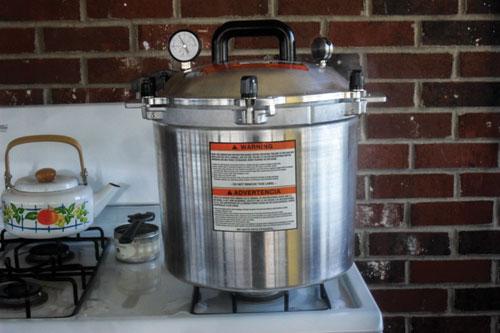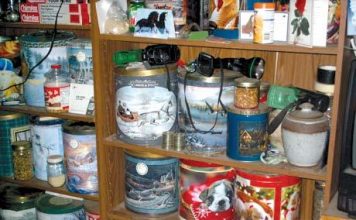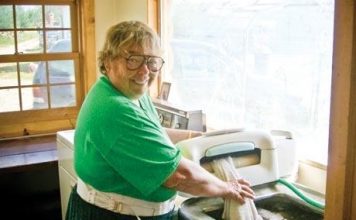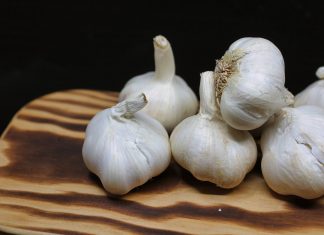| Issue #143 • September/October, 2013 |
The garden is in full swing and you have baskets of vegetables piling up; what do you do? You can them, of course. Your mother’s old granite-ware canner only works for high-acid foods like tomatoes, jams, jellies, fruits, or pickled vegetables. You cannot safely water bath can low-acid vegetables (this includes sweet corn, potatoes, green beans, peas, carrots, squash, greens, etc.) or any meats using the water bath canner. You will need a pressure canner for that.
Pressure canners come in many forms, brands, and sizes. Some operate using a gauge and some operate using a weight. Pressure canners are the only safe way to can low-acid vegetables, meat, and fish or any combination of those foods. I, personally, do not understand why anyone wouldn’t want to can with a pressure canner, especially since you can get botulism from canning meats, fish, and low-acid vegetables with a water bath canner. Pressure canners use a substantially less amount of water and fuel, which I am sure all frugal homesteaders appreciate. It requires a shorter amount of time to process compared to the hugely outdated (and dangerous) instructions for canning meat, fish, and low-acid vegetables with a water bath.
Having grown up with the stories about exploding pressure canners, some readers are probably wondering why I would want that ticking time bomb in my kitchen. Here is a little secret: If you properly use your pressure canner and understand how it works, it is nearly impossible to blow it up. It takes just a little knowledge to properly operate one.

The All American is a heavy-duty, weighted gauge pressure canner; most models are designed for large jar capacity.
Essential considerations
Regardless of what brand you are buying, there are many things to consider. Costs can vary — it’s worth spending a little more to get the one you want because odds are it will probably last several decades before being discarded, while paying for itself time and time again. But you want something that fits your needs and your resources.
If you are buying a pressure canner for the first time, your first instinct may be to buy a smaller one. This is understandable — the bigger canners can be quite intimidating. However, you will end up spending all night canning if you don’t get a good-sized one the first time. For the sake of your time and money, do not get one under the capacity of at least nine pints and seven quarts. I consider that a small canner, but to a newbie it might seem like a large one.
Imagine this scenario — it is mid-summer, your electricity is off and won’t be back on for at least a week, you just bought a whole bunch of meat on sale at the grocery, and it is in your now-hot garage in your now-dead freezer. You are working on a time frame to get it canned and if you don’t, the money you spent will go down the drain. This where a good-sized canner (like the All American #921) comes in handy; you will be able to can all that meat quickly and save most, if not all, of your food.
Make sure you get a canner, not a cooker. I have seen several retailers feature pressure cookers right next to canning jars, funnels, canning lids, and water bath canners. It is very misleading. It is not safe to can in a pressure cooker.
You also need to consider your stove type because, believe it or not, all canners do not work on the same types of stoves. Some have to work on gas ranges and will damage electric ranges or not work properly if used on an electric stove. An easy compromise is a propane camp stove. If you have a gas range canner and the electricity goes out, you will still be able to use it.
Another consideration is size; if you don’t have a lot of upper body strength, the largest All American (Model #941) is probably not best suited for you.
Presto versus All American
Before I begin my comparison of these two brands, I want you to know that I own both brands and like both of them very well, but for some folks they may not work as well. Presto pressure canners are some of the most common (and popular) canners in America. They are widely available online and in retail. All American canners seem to be more popular with survivalists and preppers. There are pros and cons to each brand.

With good care, pressure canners can last a very long time.
All American pros
These are not your stereotypical pressure canners and they work differently than the nostalgic canner with a rubber seal. All American pressure canners are made by the Wisconsin Aluminum Foundry and have a huge diversity of sizes. This is very handy if you normally can in large batches. The smallest version, Model #910, holds four quart jars and seven pint jars. I wouldn’t suggest this version, as it is too small for homestead life. In contrast, their largest canner (Model #941) holds 19 quart jars and 32 pint jars. I consider this too big and too expensive (listed at a little more than $600). However, they have models, like the Model #921, that are better suited to homestead life. It holds 7 quarts and 19 pints. This is the version I have and I enjoy it very much. It holds quite a few jars, but it isn’t too heavy. It is not as pricey as the others (about $217) but will last quite a while and is extremely reliable. These canners are very sturdy and with proper care, they will probably last for generations.
Regardless of the size of your canner, All American canners must be used on a gas range. If you try to use them on an electric range, they will scratch the stove. They also have a domed bottom which, according to manufacturers, can damage the stove. If you are an off-grid homesteader and cook with propane gas, these canners work best on those stoves.
I find the best thing about this canner is its incorporation of a dial gauge and a weighted gauge. All American canners are weighted gauge canners (they regulate pressure by a special weight on the valve instead of by manual heat adjustment). With this system you are able to successfully leave your canner on a lower heat setting and it will regulate the pressure for you. With the dial, you are able to know when the inside of the canner has successfully returned to zero pounds pressure; that way there is no question when it is ready to open. With the dial you also get to watch the pressure build up. All American canners also have an emergency release valve in case the pressure reaches dangerous levels, thus exhausting the steam. Another plus with this canner is that it has a metal-to-metal seal, and will never have to be replaced — making the purchase of a yearly rubber seal obsolete.
Presto pros
Presto pressure canners are made by National Presto Industries, and come in two sizes: a 16-quart liquid capacity model (holds 7 quarts and 9 pints) and a 23-quart liquid capacity model (holds 7 quarts and 20 pints). Both models are lightweight and are well-suited for large canning jobs. The prices are also very reasonable; the 23-quart liquid capacity model costs about $120 (depending on where you buy it). Presto canners are very sturdy and will last quite a long time with good care.
One of the more favorable qualities of the Presto pressure canner is that it works on electric ranges as well as gas ranges. This canner is strictly dial gauge, meaning that in order to maintain the appropriate pressure for your elevation you must reduce and maintain the heat. This is a big plus for those in high altitudes; you will be able to successfully can at your appropriate pressure. It does have a weight on it (which will let steam exhaust after it reaches 15 pounds pressure) as well as an emergency release valve. The newer models also have a button on them that lets you know when pressure has successfully been released from the canner; the button will drop down when you can safely remove the lid. Presto pressure canners are also the most common. They are not very hard to find and are available at stores such as Walmart for very reasonable prices.
All American cons
One of the biggest advantages for the All American pressure canner is also one of its biggest disadvantages. The weighted gauge cannot be used at 11, 12, 13, or 14 pounds pressure. For example, if you live at an altitude where you have to can at 12 pounds pressure, you must use the 15-pound setting on the regulator in order to cook the food at a high enough temperature. This can overcook foods at that altitude (between 2,000 and 3,000 feet above sea level) so this would definitely be an important consideration when selecting a canner.
All American canners are not very easy to find in retail markets, so you will likely have to order it online or from a mail order catalog.
Be advised: With this canner, you must be able to lift it onto the stove (something to remember with the Model #941) and be able to securely bolt the lid down. We learned this the hard way, even with the lighter #921 model. There are multiple canners in my house. As a 16-year-old boy, I can lift the canner and bolt it down, but my 78-year-old grandmother can’t do it alone with the #921 model, let alone with the larger #941.
Presto cons
One of the biggest disadvantages of the Presto pressure canner is that every year you must replace the rubber ring on the inside of the lid. These rings are not very expensive, but they are an additional expense you will have as long as you can with it. These rings are essential to make sure the canner seals to hold in steam and pressure.
Another trait some may not like is that the largest version holds no more than seven quarts, which can slow down big canning jobs.

These are just some of the foods that should be canned with a pressure canner.
Where can I get one?
These are the most popular brands of canners and are not very hard to locate. They can be bought new from retail stores, online, mail order, or the manufacturer.
Walmart supplies Presto pressure canners in most outlets and online, as well as the All American canners online.
Amazon has a wide range of models and sizes pooled from different stores. You can find good prices on this site.
For those of us who do not have Internet access or just prefer mail order, you can order canners from the following retailers’ catalogs:
Lehman’s Supply
1-888-438-5346
PO Box 270
Kidron, OH 44636
www.lehmans.com
Emergency Essentials
1-800-999-1863
653 North 1500 West
Orem, UT 84057
www.beprepared.com
Kitchen Krafts
1-800-298-5389
PO Box 442
Waukon, IA 52172
www.kitchenkrafts.com
You may also get lucky and find a gently-used canner at a thrift store or even a yard sale.
Buying a pressure canner is a big investment for homesteaders, and an important one at that. It is essential for your pantry. It is very important to buy what you need now instead of later. Being an owner of both of these great pressure canners, I must say they can be polar opposites in some areas. Therefore, it is important to properly investigate and search before settling on a model that is right for you.















I also have a Carey electric canner. Push button and go!!! I like it for the quarts of things I can.
Judith Mackie, I think it is the shape of the Norton of the All American.
I have had 2 identical Presto 23 qt canners for almost 30 years. I have never replaced the gasket every year. It has not been necessary to do so if you take care of them properly. I have replaced the gasket on each twice; the gauge on each once and the little over-pressure plug once. Unless they are now making the gaskets of different grade material I can’t think why anyone would replace it yearly.
I am not the author…..but to comment…..I use my presto canner on a conventional coil stove top. I dont think the scratching applies. I also have used it in a flat top….but….had my husband carefully LIFT it off the flat burner area at the end of processing and place it on a heat pad on the counter. No problems there either.
Judith, I am assuming the scratching occurs on glass cooktops, as opposed to the exposed electric element type stove.
Can you clarify the statement about the All American scratching the electric stove top? I have only canned water bath and am in the market for a pressure canner. Is it that the dimensions over-hang the electric element? Even so, I am unable to visualize the scratching part.
Thank you for your review ! It has helped me in my decision-making.
Judith Mackie